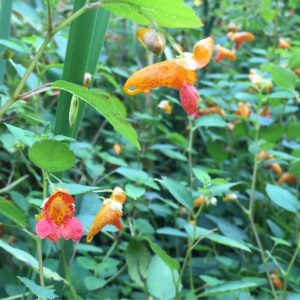
Featuring Beneficial “Local Weeds”.
Wild Blue Violets (Viola sororia or papilionacea spp.)
Leaves of the common blue violet (e.g. Viola sororia and papilionaceae species) are an edible source of vitamins C and A and have been used as cooked greens and in salads. The blooms are used to make jellies, which appear each spring at our local farmer’s markets. The mucilaginous substances in violets have demulcent and moisturizing qualities. The herb has been used for respiratory ailments, as an antinflammatory, and for treatment of wounds, scrapes scars and various skin conditions.Violet tea is added to a non scented soap for the gentlest skin care.
Plantain (Plantago spp.)
Leaves of plantain have traditionally been used world wide as poultices for wound healing. They contain compounds which exhibit numerous activities such as anti-inflammatory, cell growth promotion, anti-oxidant, weak antibiotic, immune modulating. Aucubin, allantoin, flavonoids, copious amounts of mucilage and derivatives of caffeic acid are present in this plant. The very young leaves are considered edible, with substantial vitamin and mineral content. Seeds have been used as a bulk laxative. Experiencing the Plantain line of soaps offered by The Suds Pharm might cause you to stop using the weed spray on this plant and allow it to overtake the lawn. 😀
Comfrey ( Symphytum officianale)
The genus name of Comfrey, comes from the Greek word symphis, which refers to the knitting of bones together. One of the old names of this traditional herb is “Boneset”, (which can cause it to be confused with the other “Boneset”, Eupatorium perfoliatum). It was used externally as a poultice to promote healing, and taken internally for a variety of ailments, from bruises, and fractures to stomach ulcers and female disorders. In recent decades, some experimental results in animals (using huge doses ) implicated Comfrey in liver failure, which was attributed to the presence of pyrrozolidine alkaloids. It is not known which species of plant was used, S. officianale or S. uplandicum. Numerous herbalists continue to drink the tea of S. officianale, which is said to have much lower amounts of those compounds, and has been used as fodder for domestic animals, as well as for composting. The healing quality of Confrey is attributed to a compound called allantoin, which promotes skin granulation processes. The topical use of Comfrey leaf poultices continues to be considered generally safe, but use on open wounds is not advised at this time.Comfrey Tea soaps are offered to rebels, who, like this soap maker, thumb their noses at the obsessive caution of regulators who have no rational sense of relative risk.
Jewelweed (Impatiens capensis)
Jewelweed has gained fame for use as a poison ivy treatment or preventative. Lawsone, a compound that gives color to the Jewelweed extract was credited with this activity against the dermatitis, but recent studies suggest that perhaps another ingredient is responsible for the action. Jewelweed mash has been found to be the most useful to prevent the formation of a rash after exposure to poison ivy, and is the best bet when a hot shower is not available. Various alcohol and oil extracts might not be so effective. Your best weapon after exposure is to toss your clothes directly into the laundry, jump into the shower and soap up like crazy, to remove the urushiol oils of poison ivy from the skin. Of course the massive lather of Pharmer’s Jewelweed soaps are going to serve your needs best.
About that lawsone (2-hydroxy-1,4,-napthoquinone) in Jewelweed: its other name is hennotannic acid, the same red-orange dye found in leaves of the henna plant, Lawsonia inermis. It binds to keratin in skin and hair, and is used for tattoos and hair color in various parts of the world. It provides a natural orange to red brown cast to soaps. Jewelweed harvested late in the summer provides the most intense color
“Imported Weeds”
Oolong Cha (Black Dragon Tea)
Imported from mainland China and Taiwan, Oolong tea is composed of partially fermented leaves of Camellia sinensis, (somewhat between green tea and black tea). Its credited with skin protective properties due to the presence of antioxidant polyphenols. Also present are catechins, which may inhibit the release of histamine, and mitigate allergenic responses. Eczema and psoriasis sufferers report benefits from drinking the tea, and from topical applications.Oolong tea imparts a very mild fresh scent to soap, and together with the conditioning oils, leaves the skin feeling smooth and soft.
Hemp (Cannibis Sativa)
The oil from Cannibis sativa is pressed from seeds of non-GMO hemp plants, and is perfectly legal to purchase in the U.S.. It imparts no buzz at all, as the THC content is vanishingly small. It’s imported from Canada, where growing non-drug Cannabis for rope, textiles and oil is allowed. This oil contains gamma linoleic acid and essential fatty acids as well as vitamin E. It has been credited with natural skin conditioning abilities, and with alleviating symptoms of eczema. as well as being useful and nutritious for cooking purposes.
The Wildwood series of soaps contain 10% cannabis oil for extra creamy lather and moisturizing benefits for the skin. Some of the other soaps with 5% cannibis oil will also produce very stable and creamy lather.
Disclaimer
Despite the fact that this soap maker IS a medical professional, there are no therapeutic or curative claims being made for these soap products. There is a strong desire to avoid the massive costs of compliance with government regulations on medicinal and cosmetic products. This will allow you, the customer, the opportunity to enjoy the benefits of home made, cold process soap on the skin for a reasonable and affordable price.
Ingredients of the soap products are provided in detail so that you can be fully informed. This will enable you to avoid any compounds known to be personally allergenic, and to choose the most beneficial and attractive products.
These soap products are continually subjected to limited animal testing on the soap maker and her family. They all love it.